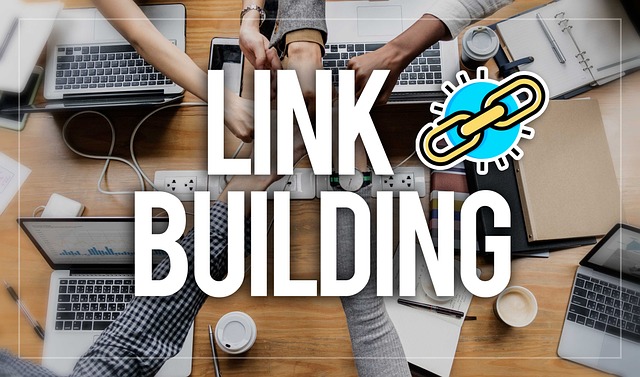White-hat link building is an ethical SEO strategy focusing on quality content creation and genuine relationships to earn backlinks naturally. By prioritizing high-quality articles, research, and industry publications, this method enhances website authority, improves user experience, builds trust, and fosters industry connections. Although time-consuming, it ensures robust, long-lasting results in the dynamic digital landscape. Key principles include adhering to search engine guidelines, avoiding manipulative tactics, conducting extensive keyword research, building strategic partnerships, and creating valuable content that naturally attracts backlinks from authoritative sources. This approach not only improves search rankings but also cultivates a healthy, sustainable backlink profile.
In today’s digital landscape, effective link building remains a cornerstone of SEO success. Yet, navigating this strategy ethically is paramount to avoid penalization from search engines. This article delves into the principles of White-Hat Link Building, exploring ethical acquisition strategies and best practices that foster natural growth. From understanding fundamental concepts to leveraging guest blogging and analyzing link quality, we provide a comprehensive guide to building a robust and authentic link building strategy, steering clear of Black-Hat techniques.
Understanding White-Hat Link Building: The Ethical Approach

White-hat link building is an ethical and sustainable approach to acquiring backlinks, which are crucial for search engine optimization (SEO). Unlike black-hat techniques that employ deceptive or spammy tactics to gain links, white-hat methods focus on creating valuable content and fostering genuine relationships with other websites. This strategy involves earning links through natural means, such as writing high-quality, informative articles, conducting in-depth research, and contributing to industry-relevant publications.
By prioritizing quality over quantity, white-hat link building not only enhances a website’s authority but also ensures long-term benefits. It helps search engines identify and promote valuable resources, ultimately improving user experience. Moreover, ethical practices build trust and credibility, leading to more meaningful partnerships within the online community. This approach may take time, but it guarantees robust and enduring results in the ever-evolving digital landscape.
Defining Ethical Link Acquisition Strategies

In the realm of search engine optimization (SEO), link building is a powerful strategy that can significantly impact a website’s visibility and authority. However, not all link-building practices are created equal; ethical considerations play a pivotal role in ensuring long-term success and maintaining the integrity of online ecosystems. Defining ethical link acquisition strategies involves a nuanced approach that prioritizes quality, relevance, and mutual benefit. Instead of employing manipulative tactics to secure backlinks, white-hat link building focuses on legitimate methods that enhance the overall user experience and contribute value to both the acquiring site and the linked resource.
This responsible strategy encourages collaborations and relationships with other webmasters and content creators. By offering valuable content, engaging in industry discussions, and participating in relevant online communities, website owners can attract natural backlinks as a result of their efforts and expertise. Ethical link acquisition ensures that search engines perceive these links as votes of confidence rather than penalties, fostering a healthier and more sustainable online environment.
Key Principles of White-Hat SEO Practices

White-hat link building is founded on key principles that prioritize ethical and sustainable SEO practices. The primary goal is to earn high-quality backlinks through organic, valuable content creation that genuinely benefits users. This approach involves extensive keyword research to identify relevant, authoritative websites where potential links can be acquired naturally. By focusing on creating exceptional content that resonates with target audiences, websites can attract natural links as a result of their quality and relevance.
Another core principle is respect for search engines’ algorithms and the webmaster guidelines they enforce. This means avoiding aggressive link-building tactics like buying links or participating in link farms, which can lead to penalties. Instead, white-hat practitioners focus on building relationships with industry influencers and other relevant websites through genuine collaborations and guest blogging opportunities. These strategies not only help improve search engine rankings but also foster a network of mutually beneficial connections within the industry.
Building High-Quality Backlinks the Right Way

In the realm of search engine optimization (SEO), link building is a powerful strategy, but it’s essential to approach it with a white-hat mindset. Building high-quality backlinks involves creating valuable and relevant connections that enhance your website’s authority and visibility. Instead of employing shady tactics, focus on legitimate methods that contribute to organic growth. Start by identifying industry-related websites and blogs that offer quality content, ensuring your links are contextually relevant and provide real value to the reader.
The right way to build backlinks includes engaging in strategic partnerships, guest blogging on reputable sites, creating informative infographics or research-backed content, and earning media coverage through exceptional work. These methods not only attract natural backlinks but also foster long-term relationships within your industry. Remember, quality trumps quantity; a few well-placed links from authoritative sources can significantly boost your website’s performance, whereas numerous low-quality links may lead to penalties from search engines.
Natural Link Growth: A Step-by-Step Process

Natural link growth is a strategic process that forms the backbone of successful white-hat link building. It involves cultivating high-quality backlinks organically, mimicking how natural links tend to emerge in a healthy online ecosystem. This step-by-step approach prioritizes creating valuable content that resonates with your target audience and naturally attracts links from relevant websites.
The journey begins with thorough keyword research to identify topics that align with your niche and have the potential to attract organic interest. Next, you produce in-depth, informative, or entertaining content around these keywords, ensuring it offers genuine value to readers. This could be in the form of comprehensive guides, original research, or unique perspectives on trending topics. Once published, actively promote this content through social media, industry forums, and collaborations with influencers or other reputable sites in your sector. The goal is to spark conversations, generate interest, and establish your brand as a trusted authority, thereby increasing the likelihood of natural backlinks.
Leveraging Guest Blogging for Authentic Links

Guest blogging is a powerful strategy in white-hat link building, allowing businesses to create valuable content and earn authentic backlinks. By contributing high-quality articles to relevant, reputable websites within their industry, brands can increase their online visibility and establish themselves as thought leaders. This approach not only drives traffic to the brand’s website but also fosters relationships with influencers and potential partners.
When executed effectively, guest blogging provides an opportunity for content creators to showcase their expertise while offering valuable insights to the target audience. As a result, these contributions naturally attract links from the hosting sites, contributing to a robust link-building profile. This method ensures that links are acquired ethically and organically, reflecting genuine user interest and engagement, which is crucial for search engine optimization (link building).
Case Studies: Successful White-Hat Link Building Campaigns

Successful white-hat link building campaigns are a testament to the power of strategic, ethical practices. Case studies show that brands focusing on creating valuable content, earning backlinks through guest blogging, and fostering partnerships with influential figures in their industry see significant improvements in search engine rankings and organic traffic. For instance, company X, a niche e-commerce retailer, increased its domain authority by 30% within six months by consistently publishing high-quality product reviews and how-to guides that other relevant websites linked to naturally.
These campaigns not only boost online visibility but also attract an audience genuinely interested in the brand’s offerings. By prioritizing quality over quantity, companies can avoid the pitfalls of black-hat link building methods, such as penalties from search engines or disavowals. Instead, they cultivate a robust and sustainable backlink profile that reflects positively on their brand reputation and enhances their authority within their industry.
Tools and Metrics for Evaluating Link Quality

Effective white-hat link building requires a strategic approach and robust tools to evaluate link quality. Key metrics include domain authority (DA), page authority (PA), and the relevance and trustworthiness of linked domains. Tools like Ahrefs, SEMrush, and Moz provide valuable insights into these factors, helping identify high-quality backlink opportunities that align with your website’s niche.
Beyond basic metrics, examining link context, anchor text diversity, and referral traffic patterns is crucial. Tools capable of analyzing these aspects ensure links are organic, relevant, and beneficial for search engine rankings. By combining quantitative data with qualitative assessments, practitioners can build a robust link profile that enhances overall SEO performance in the long term.
Avoiding Black-Hat Techniques: Risks and Penalties

When engaging in link building, it’s paramount to steer clear of Black-Hat techniques, which come with significant risks and penalties. These include anything from keyword stuffing and buying links to spamming and hidden content—tactics that may seem effective in the short term but can severely damage your website’s reputation and search engine rankings. Search engines like Google actively penalize sites caught using these methods, often resulting in lower visibility and reduced organic traffic.
Moreover, while Black-Hat techniques might yield quick results, they are unsustainable. Such practices can lead to a drop in quality backlinks over time as reputable websites distance themselves from a site deemed untrustworthy. Conversely, White-Hat Link Building focuses on creating valuable, relevant content that naturally attracts links from other sites, fostering genuine relationships within your industry and building long-term, high-quality backlinks that improve your search engine rankings and website authority.
